“Gates of Paradise” by Lorenzo Ghiberti – A Detailed Analysis
The Gates of Paradise by Lorenzo Ghiberti took over two decades to make, and were important additions to the Baptistry of Florence in Italy as part of the east side. These doors were masterpieces from the Renaissance period and have stood the test of time for centuries. Below, this article will discuss how these doors originated and how they were made, so read on!
Contents
Artist Abstract: Who Was Lorenzo Ghiberti?
Lorenzo Ghiberti was born around 1378 In Pelago, Florence, and died from a fever on December 1, 1455, in Florence. He was a Gothic and early Renaissance sculptor, painter, and goldsmith who received numerous outstanding commissions during his artistic oeuvre and gained a high level of success. He was married to a girl named Marsila and had two sons, namely Tommaso and Vittorio. Some of his famous artworks include The Sacrifice of Isaac (1401 – 1402), St. John the Baptist (1412 – 1416), and Saint Stephen (1427 – 1428).
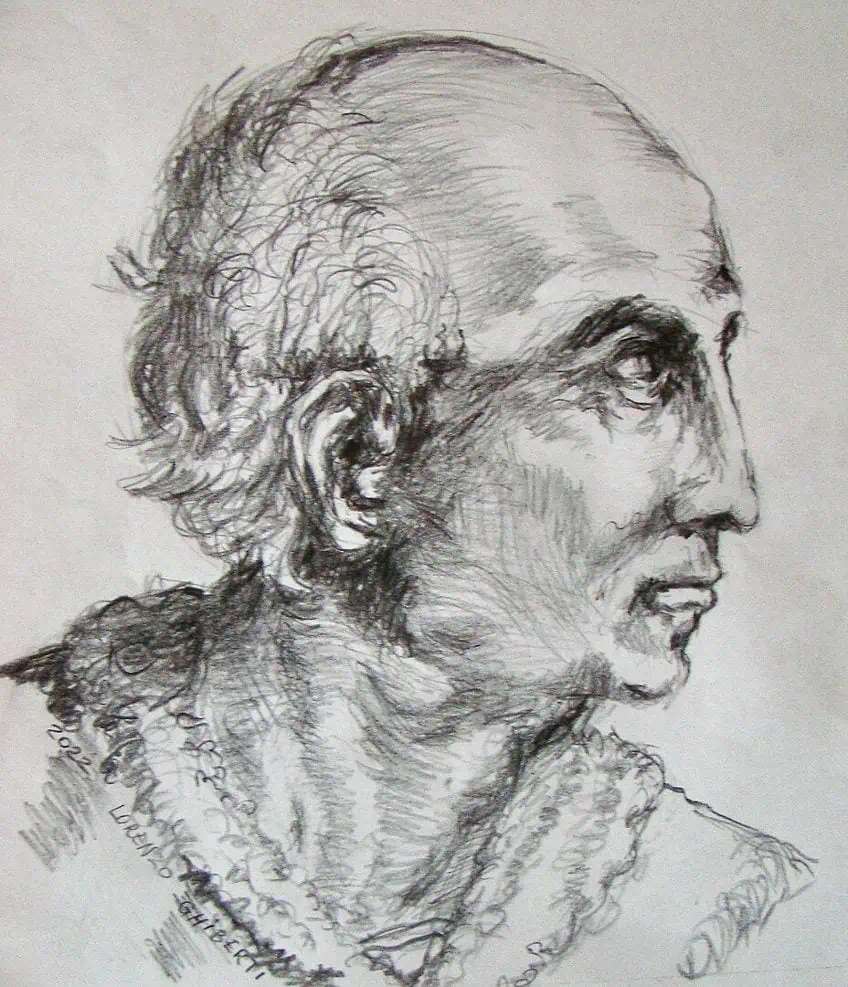
Gates of Paradise (c. 1425 – 1452) by Lorenzo Ghiberti in Context
| Artist | Lorenzo Ghiberti |
| Date Painted | c. 1425 – 1452 |
| Medium | Bronze and gold |
| Genre | Sculpture |
| Period/Movement | Early Italian Renaissance |
| Dimensions (Feet) | 17 |
| Series/Versions | N/A |
| Where Is It Housed? | Comprised the eastern gate of the Baptistry of Florence but are now reportedly held at the Museo dell’Opera del Duomo Museum in Florence, Italy |
| What It Is Worth | It was commissioned by the Arte di Calimala (Wool Merchants Guild) in 1425 |
In the contextual analysis below, you will read more about what the Gates of Paradise by Lorenzo Ghiberti is and how it was constructed and eventually named. Through a formal analysis, you will read more about each of the 10 panels that comprise this gilded bronze masterpiece and how the art elements compose it.
Contextual Analysis: A Brief Socio-Historical Overview
The Gates of Paradise by Lorenzo Ghiberti took 27 years to complete and was started in 1425 and completed in 1452. They consist of 10 gilded bronze sculptural relief panels decorating the eastern doors of the Baptistry of Florence (Baptistry of Saint John) in Florence, Italy.
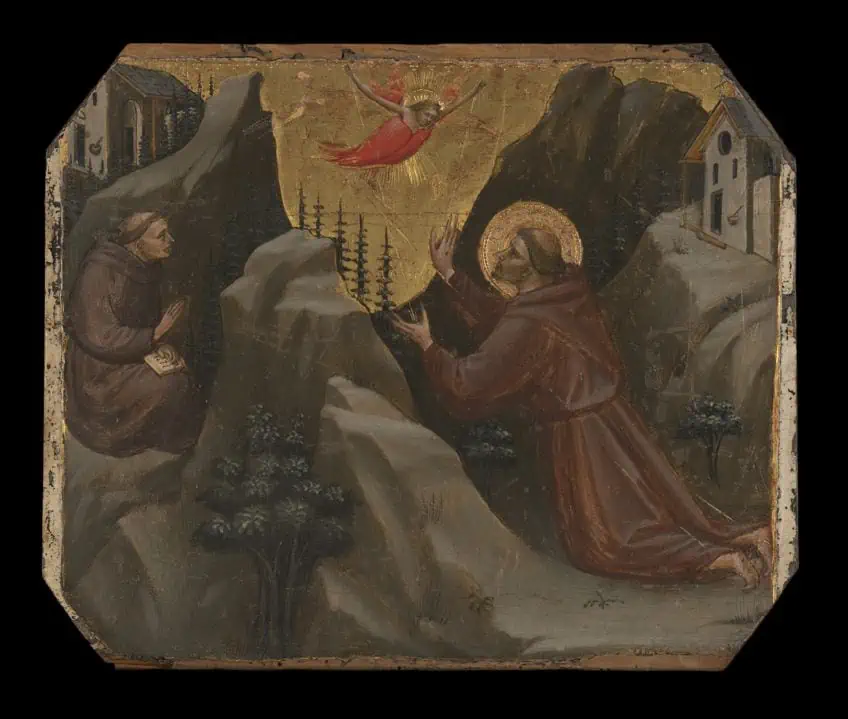
The Baptistry of Florence and Three Doors
The Piazza del Duomo is often described as the “heart” of the center of the city of Florence, Italy. In English, it is called the “Cathedral Square”. Within this area are several historic and monumental buildings, which include the Baptistry of Florence, otherwise named the Baptistry of Saint John. Across from it is Florence Cathedral and Campanile di Giotto. The Baptistry of Florence was reportedly consecrated by Pope Nicholas II in 1059 and construction lasted until 1128, which was done in the Romanesque style. However, before this, the baptistry was thought to be a pagan temple for the Roman god called Mars, who was the god of war.
The baptistry is in the shape of an octagon, which was characteristic of Christian buildings, notably for the purpose of baptism and it has been designated as a minor basilica.
There are three entrances to the baptistry, namely the north, south, and east. The west side of the baptistry is the altar wall. The three entrances comprise of double doors, all of which have been masterfully decorated by renowned Gothic/Proto-Renaissance and Renaissance artists, namely Andrea Pisano and Lorenzo Ghiberti. The first doors made for the Baptistry of Florence were by Andrea Pisano, which are the south doors. These were created around 1329/1330 and consist of 28 panels in quatrefoil shapes. The themes center around Saint John the Baptist’s life, which comprise the uppermost 20 panels.
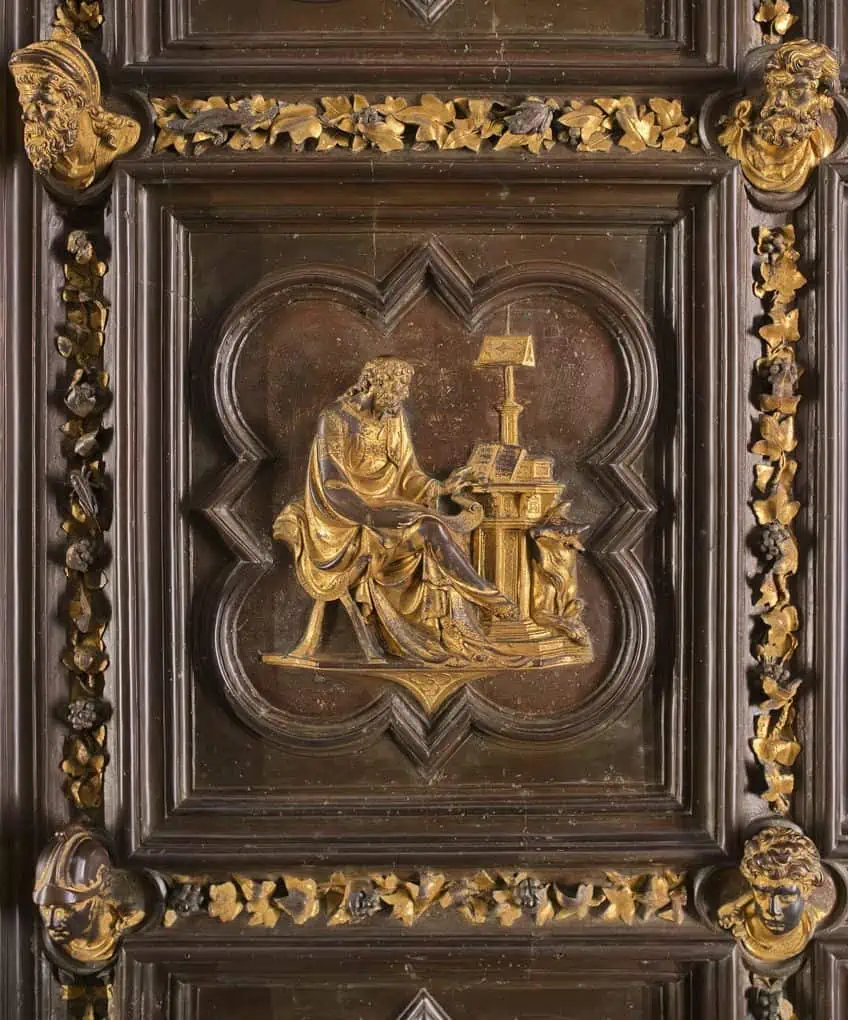
The eight panels on the lower section, the last two rows (this includes a cross-over of both doors), depict the eight virtues, namely Hope, Faith, Charity, Humility, Fortitude, Temperance, Justice, and Prudence. The north and east door panels were created in the early 1400s by Lorenzo Ghiberti, which will be discussed in more detail below.
A Tale of Two Commissions and a Competition
The Gates of Paradise bronze door panels were commissioned by the Wool Merchants Guild, known as Arte di Calimala, in 1425 and placed on the east side of the Baptistry of Florence. These were Ghiberti’s second commission for the Baptistry. The artist’s first commission was a result of a competition held by the Arte di Calimala in 1401. The reasons for the competition were to create doors that would serve as devotional devices and because the guild wanted to create another set of doors for the baptistry, of which the first set was created by the above-mentioned Andrea Pisano in 1329/1330 to 1336.
There were several artists who took part in this competition, including Filippo Brunelleschi, Simone da Colle, Francesco di Val d’Ombrino, Niccolo d’Arezzo, Jacopo della Quercia da Siena, and Niccolo Lamberti.
Lorenzo Ghiberti won this competition with the other finalist, Brunelleschi. The competition guidelines were to create reliefs on what has been described as “four tables of brass”, which would also be according to the size of the door panels. These were also in quatrefoil shapes. The subject matter would consist of “Sacrifice of Isaac” from Genesis, from the Bible’s Old Testament. The time span for the competition was one year long. The two winning artists were reportedly set to co-create the bronze door panels after the competition because the judges reportedly loved both entries and could not make a final decision. However, according to the widely held accounts, Brunelleschi did not agree to stay on and left the project; he reportedly traveled to Rome to pursue architectural studies.
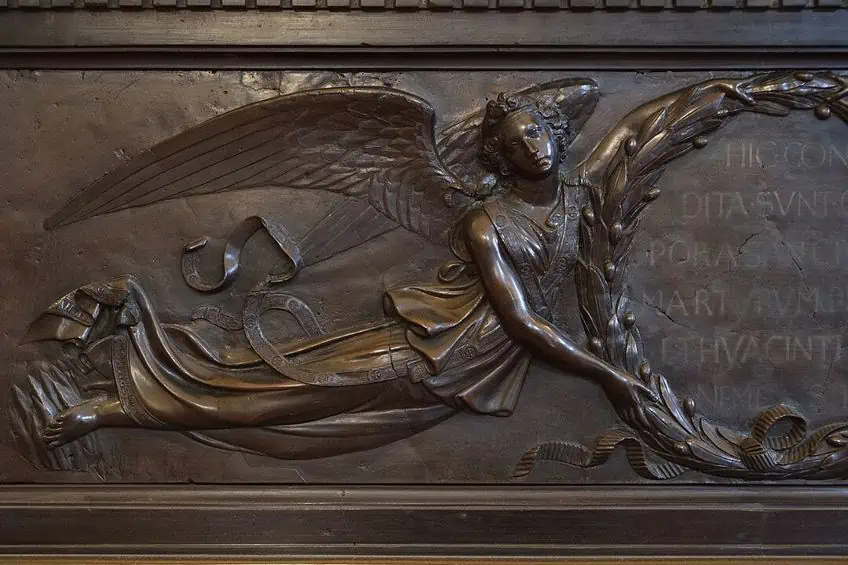
Lorenzo Ghiberti’s first commission consists of 28 quatrefoil panels, of which 20 center around themes of the Bible’s New Testament and Jesus Christ’s life. The other eight panels, two rows of four, are at the bottom of the door. The first row depicts the Four Evangelists, namely John, Matthew, Luke, and Mark (this includes a cross-over of both doors). The bottom row also includes a cross-over of both doors) depicts the four Church Fathers, namely Saint Ambrose, Saint Jerome, Saint Gregory, and Saint Augustine.
Interestingly, Lorenzo Ghiberti’s first commission, mentioned above, was initially intended for the east side of the baptistry, but it was moved to the north side after he completed his second commission, Gates of Paradise, which are now the east doors. It is important to note the changes made to the doors’ locations, which have not been clearly conveyed by numerous sources.
What Michelangelo Said About Ghiberti’s Gates of Paradise
The widely held belief is that the famous Renaissance artist, Michelangelo, was responsible for naming Ghiberti’s Gates of Paradise. Reportedly, they reminded him of the Gates of Paradise, which could be a reference relating to heaven’s doors, and the name was utilized since. However, there have also been other possible explanations tied to the name and that Michelangelo’s part could be more of a legend.
According to scholarly sources that have delved deeper into the Gates of Paradise’s meaning, there has been a connection between architecture from the medieval ages.
This includes the function of the baptistry building, which was reportedly viewed as a “gateway”. The baptistry would enable those baptized to pass through and thus be led into the Kingdom of Heaven and into their new Christian life. Other references have been mentioned about this, for example, the baptistry in Pisa was reportedly referred to as the “Porta Paradisi” during the 1200s. Additionally, the east side has been associated with the “Golden Gate” of the east wall in Jerusalem.
Formal Analysis: A Brief Compositional Overview
The formal analysis will discuss and describe the subject matter of the 10 panels that comprise the Gates of Paradise which are the eastern doors of the Baptistry of Florence in Italy. Referring to the art elements, a brief discussion will outline the important stylistic details that compose these sculptural relief scenes and ultimately the artist’s, Lorenzo Ghiberti, techniques. Lorenzo Ghiberti utilized what was known as the lost-wax casting method to create his panels. The process has been explained by various sources with various scholarly debates around the process. Below is a brief outline of what the process reportedly included.

Lorenzo Ghiberti reportedly started the process of his bronze door panel designs by creating drawings and models in clay and then created wax models of the panels. Wax rods were reportedly then added to the back of the relief models, which were then covered in clay that resisted fire so that when it was heated the wax melted and left the mold empty (or hollow).
After this process, Ghiberti reportedly started the process of carving and polishing the reliefs after they were cast. The artist also reportedly painted the reliefs with a gold dust and mercury combination. He then heated the reliefs, which reportedly “burned” the mercury off, and kept the gold on the relief.
Subject Matter: Visual Description
The Gates of Paradise by Lorenzo Ghiberti is composed of 10 main panels on two doors, five panels per door. Below you will read more about what each panel depicts, which are Biblical scenes of the Old Testament. Additionally, around the doors are borders consisting of 24 heads and figures of prophets.
The order of arrangement will start with the top panel of the left door to the bottom then continue from the top of the right door to the bottom.
The Creation of Adam and Eve
This panel depicts several parts of the story of Adam and Eve. This includes their creation, temptation, and eventually expulsion from paradise. The upper section depicts God’s creation of life and the Garden of Eden. Along the left edge in the middle ground are the two figures of Adam and Eve standing next to the tree with the serpent coiled around its trunk.
The lower left corner has been described as depicting the fall of Lucifer and God standing over him holding out His right arm and holding Lucifer’s outstretched right hand.
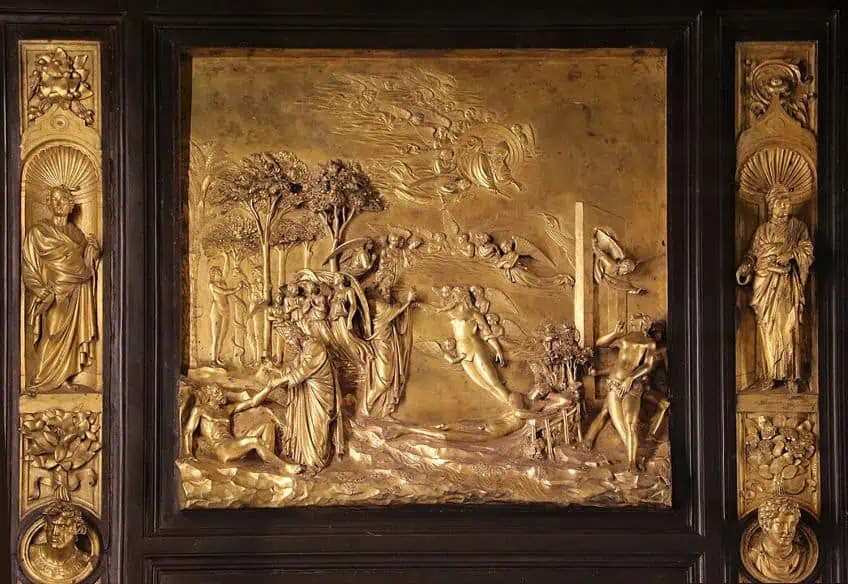
Noah
This panel depicts several scenes relating to the story of Noah and the Ark. In the background appears a large pyramid, which has been described as the Ark. There are several types of animals around the ark, for example, coming out of the left edge is an elephant and there are lions to the right. Lying in the lower left corner is the figure of the drunken Noah.

Isaac and Jacob
This panel depicts the story around Isaac, Rebecca, and their sons Esau and Jacob. In the upper right corner is the figure of Rebecca on the rooftop, she is receiving a prophecy from God about her two sons and their conflict. Towards the right edge of the middleground is the figure of Jacob, who walks out of the scene to go hunting.
In the foreground are several groups of figures all relating to Jacob’s blessing.
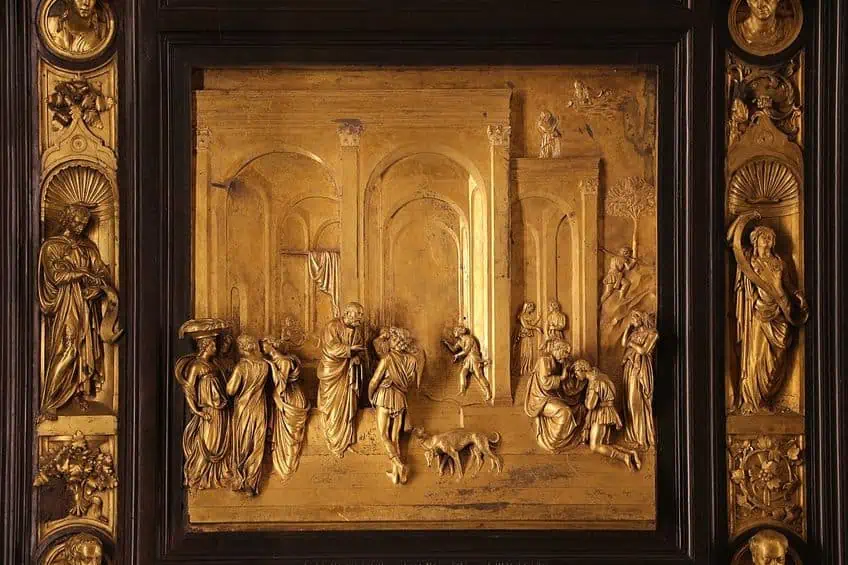
Moses
This panel illustrates Moses’ story, depicting him on the top of Mount Sinai towards the upper right of the composition. In the foreground of the composition are several figures standing at the bottom of the mountain.
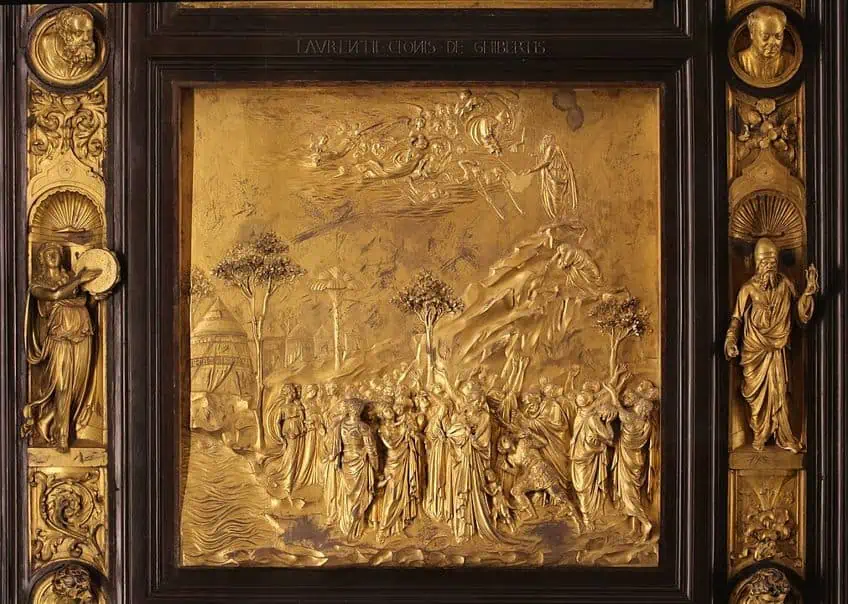
David and Goliath
This panel is about David and Goliath. It depicts David towering over the slain Goliath, lying dead on the ground in the immediate foreground.
Surrounding the two figures are numerous soldiers and a naturalistic landscape that recedes into the background revealing a town in the distance.

Cain and Abel
This panel depicts several scenes from Cain and Abel’s story. For example, in their sacrifices, Abel sits with his is to the left in the middleground, and the right middleground depicts Cain killing Abel.

Queen of Sheba and Solomon
The final panel depicts the story of King Solomon and his marriage to Queen Sheba, who are both depicted as the central figures with many other figures around them. They are surrounded by an architectural background of the church, which skilfully recedes into the background, creating a dynamic sense of depth.
Interestingly, this panel has been believed to symbolize the churches of the West and East, namely King Solomon as the West and Queen Sheba as the East, and when these met, they were at the Duomo in Florence, Italy on July 9, 1439.
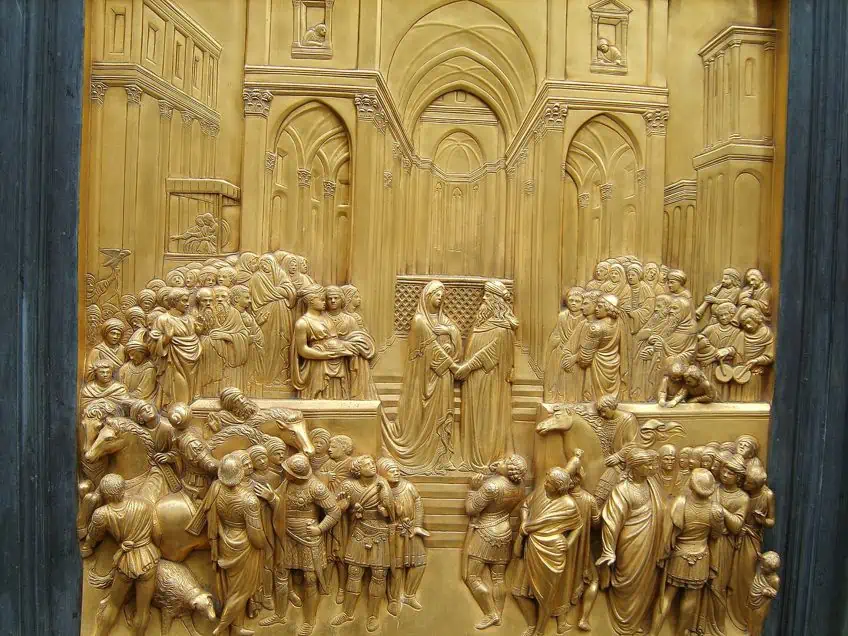
Abraham
This panel depicts Abraham and three angels in the lower left corner, the Sacrifice of Isaac and the angel intervening in the background, near the upper right corner, and in the lower right corner are two figures sitting and a cow grazing.
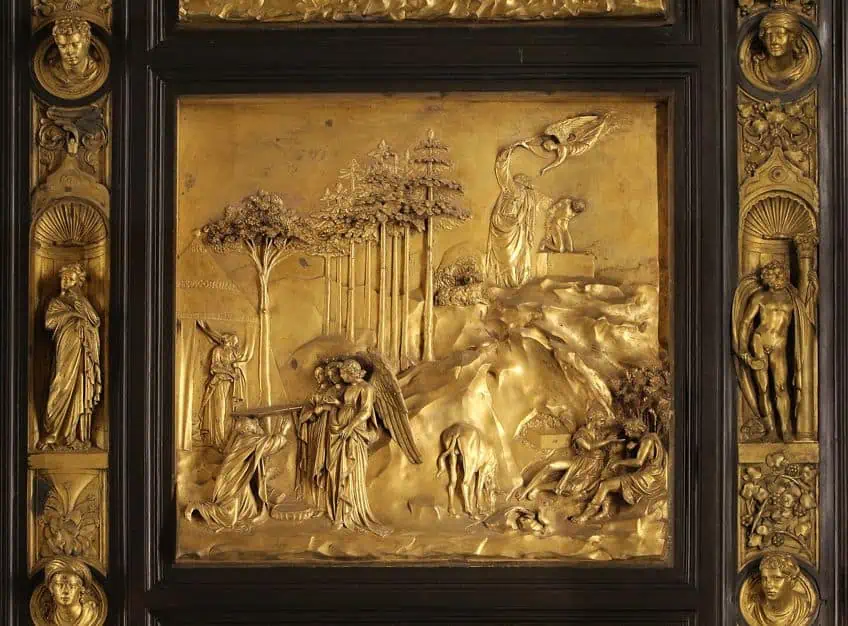
Joshua
This panel illustrates Joshua’s story and the Fall of Jericho, depicting his army with their trumpets around the city’s walls in the background. In the middleground are several tents and in the foreground are more figures who resemble the Israelites that were led by Joshua and crossed the River Jordan.
This is depicted in the central foreground.
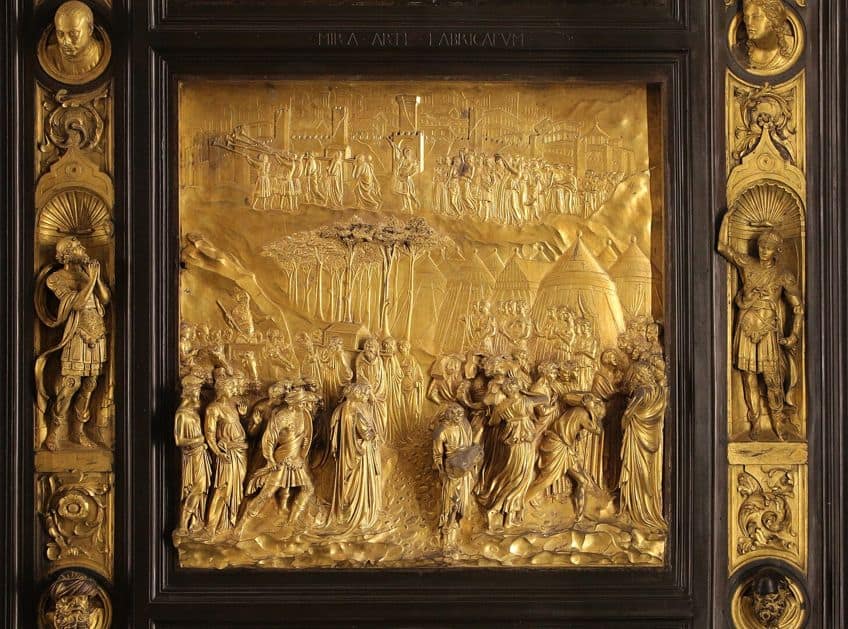
Joseph Sold into Slavery
This panel depicts several figures arranged throughout an architectural background. It portrays various moments from Joseph’s life, including when he was sold into slavery to analyzing the pharaoh’s dreams.
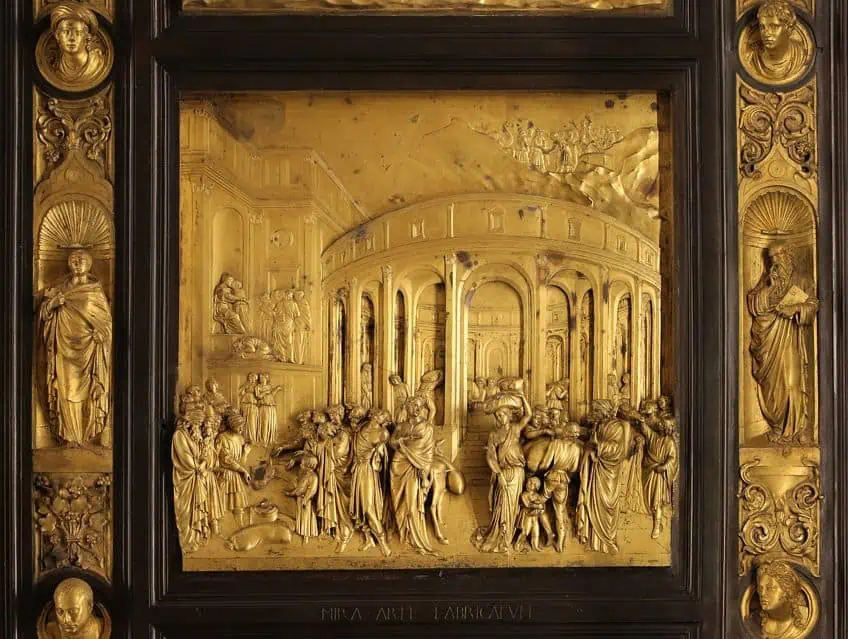
Color
The color of the Gates of Paradise by Lorenzo Ghiberti is a beautiful, gilded bronze and there are no other colors added to this piece.
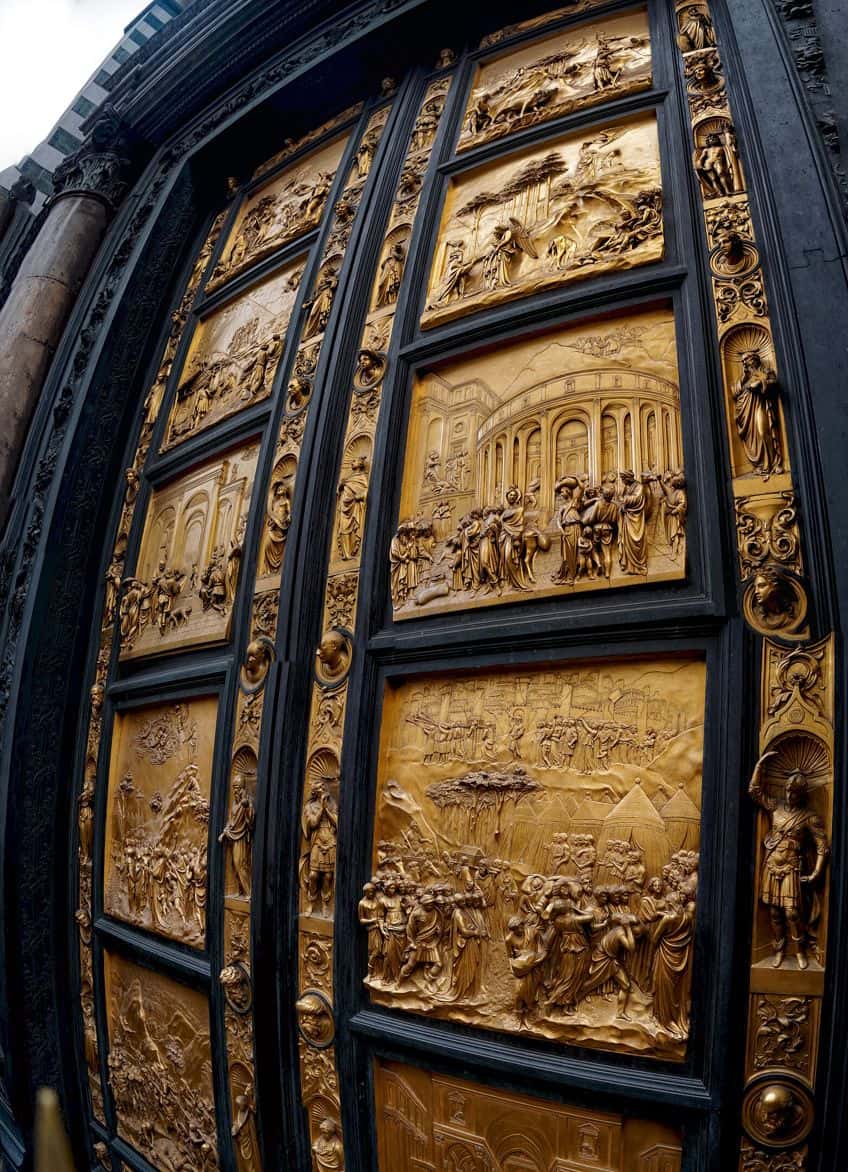
Texture
There is implied texture in Lorenzo Ghiberti’s bronze door panels and each composition, for example, the smooth and folded textures of the figures’ fabrics or the coarser textures of the depicted natural environments.
The relief style itself also creates a tactile texture on the bronze door panels, which creates a sense of depth and three-dimensionality.
Line
The type of lines that occur in Gates of Paradise by Lorenzo Ghiberti are naturalistic with a variety of curved, straight, and diagonal lines all delineating the different compositions in each of the bronze door panels.
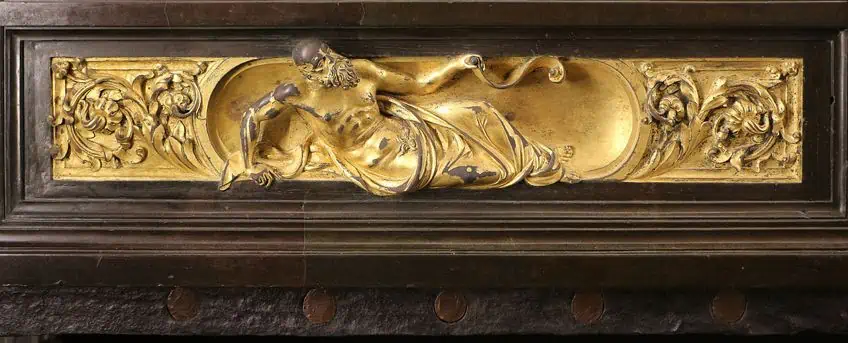
Shape and Form
The type of shapes and forms that occur in Gates of Paradise by Lorenzo Ghiberti are naturalistic and organic, in other words, these are free-flowing and follow forms you will find in nature. The relief carving of each panel creates a three-dimensionality compared to the flatter surfaces of canvases, for example, where three-dimensionality is implied.
The door’s shape is overall vertical rectangular shape, and the panels are each square shape, which creates a more geometric quality that encompasses the intricate curves and forms of the panels’ carvings.
Space
Lorenzo Ghiberti skilfully utilized perspectival techniques in his Gates of Paradise bronze door panels, and each of the compositions. Some of the techniques include linear perspective with set vanishing points. Another technique that Ghiberti utilized to create spatial depth, otherwise also referred to as aerial perspective, included how he portrayed the carvings.

For example, the subject matter in the foreground appears higher compared to the subject matter in the background. Additionally, a sense of depth is also depicted through Ghiberti’s utilization of size and scale, for example, the subject matter appears smaller in the background and larger in the foreground in the panels.
Portals to Paradise
It can be confusing to read about the Gates of Paradise bronze door panels and their history, therefore, let us recap. The Baptistry of Florence has three sets of double doors on the North, South, and East sides. The first set was created by Andrea Pisano (South) and the second and third sets by Lorenzo Ghiberti (North and East). The Gates of Paradise by Lorenzo Ghiberti has received extensive restoration over the years and was removed in 1990. They are reportedly now housed at the Museo dell’Opera del Duomo museum in Florence, Italy.
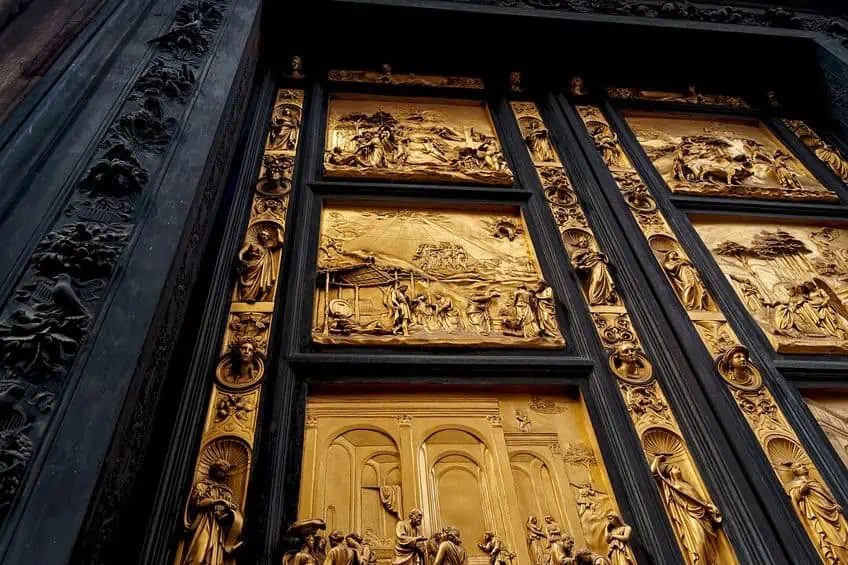
The Gates of Paradise by Lorenzo Ghiberti is a masterpiece and a piece of artwork that can be adored for hours on end. These are a set of doors beautifully created from gilded bronze, cast and carved. They undoubtedly set the standard as portals to paradise, or heaven, as the famed Michelangelo thought when he first set his sights on them.
Frequently Asked Questions
What Are the Gates of Paradise in Florence?
The Gates of Paradise (c. 1425 – 1452) by Lorenzo Ghiberti are gilded bronze doors from the Renaissance period, which were made for the eastern gate of the Baptistry of Florence. These all depict scenes from the Old Testament in the Bible.
How Many Panels Do the Gates of Paradise Consist Of?
The gilded bronze doors known as the Gates of Paradise (c. 1425 – 1452) by Lorenzo Ghiberti consist of 10 square/rectangular panels, each with Biblical scenes from the Old Testament. Bordering the panels are representations of various figures like prophets, sybils, and heroines, which were reportedly connected to the prophecy of Jesus Christ’s birth.
What Are the Gates of Paradise in Florence Made Of?
The Gates of Paradise (c. 1425 – 1452) by Lorenzo Ghiberti are made from gilded bronze, and reportedly, Ghiberti utilized the lost-wax casting technique. These depict relief scenes from the Old Testament in the Bible.
Who Named It Gates of Paradise?
The gilded bronze door panels by Lorenzo Ghiberti, titled Gates of Paradise (c. 1425 – 1452), were reportedly given their name due to the Renaissance artist Michelangelo’s, admiration of them, who associated the doors with the so-called Gates of Paradise, which possibly refers to heaven. However, this has also been known as a legend, and the name may have originated from the idea that the building of the Baptistry served as a so-called portal to heaven.
Jordan Anthony is a Cape Town-based film photographer, curator, and arts writer. She holds a Bachelor of Art in Fine Arts from the University of the Witwatersrand, Johannesburg, where she explored themes like healing, identity, dreams, and intuitive creation in her Contemporary art practice. Jordan has collaborated with various local art institutions, including the KZNSA Gallery in Durban, the Turbine Art Fair, and the Wits Art Museum. Her photography focuses on abstract color manipulations, portraiture, candid shots, and urban landscapes. She’s intrigued by philosophy, memory, and esotericism, drawing inspiration from Surrealism, Fluxus, and ancient civilizations, as well as childhood influences and found objects. Jordan is working for artfilemagazine since 2022 and writes blog posts about art history and photography.
Learn more about Jordan Anthony and about us.
Cite this Article
Jordan, Anthony, ““Gates of Paradise” by Lorenzo Ghiberti – A Detailed Analysis.” artfilemagazine – Your Online Art Source. November 14, 2023. URL: https://artfilemagazine.com/gates-of-paradise-by-lorenzo-ghiberti/
Anthony, J. (2023, 14 November). “Gates of Paradise” by Lorenzo Ghiberti – A Detailed Analysis. artfilemagazine – Your Online Art Source. https://artfilemagazine.com/gates-of-paradise-by-lorenzo-ghiberti/
Anthony, Jordan. ““Gates of Paradise” by Lorenzo Ghiberti – A Detailed Analysis.” artfilemagazine – Your Online Art Source, November 14, 2023. https://artfilemagazine.com/gates-of-paradise-by-lorenzo-ghiberti/.


